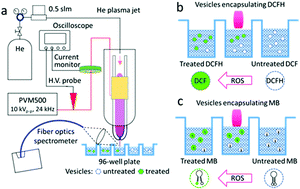How membrane lipids influence plasma delivery of reactive oxygen species into cells and subsequent DNA damage: an experimental and computational study
Abstract
The mechanisms of plasma in medicine are broadly attributed to plasma-derived reactive oxygen and nitrogen species (RONS). In order to exert any intracellular effects, these plasma-derived RONS must first traverse a major barrier in the cell membrane. The cell membrane lipid composition, and thereby the magnitude of this barrier, is highly variable between cells depending on type and state (e.g. it is widely accepted that healthy and cancerous cells have different membrane lipid compositions). In this study, we investigate how plasma-derived RONS interactions with lipid membrane components can potentially be exploited in the future for treatment of diseases. We couple phospholipid vesicle experiments, used as simple cell models, with molecular dynamics (MD) simulations of the lipid membrane to provide new insights into how the interplay between phospholipids and cholesterol may influence the response of healthy and diseased cell membranes to plasma-derived RONS. We focus on the (i) lipid tail saturation degree, (ii) lipid head group type, and (iii) membrane cholesterol fraction. Using encapsulated molecular probes, we study the influence of the above membrane components on the ingress of RONS into the vesicles, and subsequent DNA damage. Our results indicate that all of the above membrane components can enhance or suppress RONS uptake, depending on their relative concentration within the membrane. Further, we show that higher RONS uptake into the vesicles does not always correlate with increased DNA damage, which is attributed to ROS reactivity and lifetime. The MD simulations indicate the multifactorial chemical and physical processes at play, including (i) lipid oxidation, (ii) lipid packing, and (iii) lipid rafts formation. The methods and findings presented here provide a platform of knowledge that could be leveraged in the development of therapies relying on the action of plasma, in which the cell membrane and oxidative stress response in cells is targeted.



 Please wait while we load your content...
Please wait while we load your content...